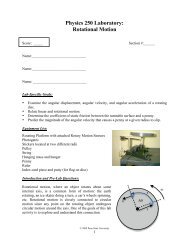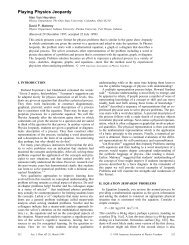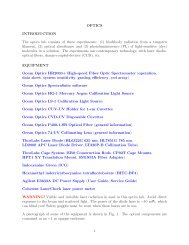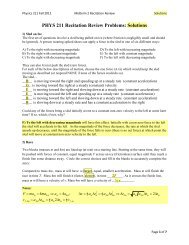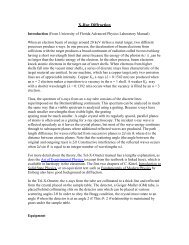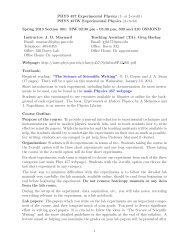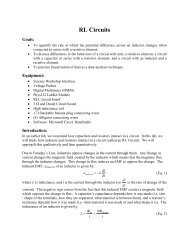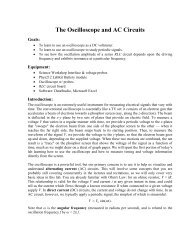Quadratic formula: Kinematics under constant acceleration: Average ...
Quadratic formula: Kinematics under constant acceleration: Average ...
Quadratic formula: Kinematics under constant acceleration: Average ...
You also want an ePaper? Increase the reach of your titles
YUMPU automatically turns print PDFs into web optimized ePapers that Google loves.
<strong>Average</strong> & instantaneous velocity<br />
and <strong>acceleration</strong>:<br />
~v average =<br />
! x<br />
t<br />
~v = d~x<br />
dt<br />
<strong>Kinematics</strong> <strong>under</strong> <strong>constant</strong> <strong>acceleration</strong>:<br />
~v (t) =~v (t 0 )+~a [t t 0 ] v x (t) 2 = v x (t 0 ) 2 +2a x [x(t) x(t 0 )]<br />
~r (t) =~r (t 0 )+~v (t 0 )[t t 0 ]+ 1 2 ~a [t t 0] 2 ...and similarly for y and z components.<br />
~a average =<br />
! v<br />
t<br />
~a = d~v<br />
dt = d 2 ~x<br />
dt 2<br />
~r (t) =~r (t 0 )+ 1 2 [~v (t)+~v (t 0)] t<br />
Vectors:<br />
Forces:<br />
F net = ma<br />
⇥A · ⇥B = AB cos<br />
= A x B x + A y B y + A z B z<br />
|F gravity | = mg<br />
F kinetic friction = µ k N<br />
A = |A| = A 2 x + A 2 y + A 2 z A x = A cos A y = A sin<br />
Where θ for components is measured<br />
counter-clockwise from the î direction.<br />
F spring = k(x x 0 ) F static friction µ s N<br />
F gravity = GmM<br />
r 2<br />
(between two point masses)<br />
Uniform circular<br />
motion:<br />
a centripetal = v2<br />
r<br />
v =<br />
r<br />
T = 2 r<br />
v<br />
<strong>Quadratic</strong> <strong>formula</strong>:<br />
ax 2 + bx + c =0 x = b ± ⇥ b 2 4ac<br />
2a<br />
Drag Forces:<br />
~F = bv ˆv<br />
~F = 1 2 C⇢Av2 ˆv<br />
(low speed)<br />
(high speed)<br />
(v with a hat on it is a unit vector<br />
in the direction of the velocity).<br />
Work and kinetic<br />
energy (linear and<br />
rotational):<br />
r f<br />
K = 1 W = F · dr<br />
2 mv2 W = K f K i<br />
K = 1 2 I 2 W =<br />
r i<br />
f<br />
i<br />
⇤⇥ · ⇤d
Angular velocity and <strong>acceleration</strong>:<br />
⇥ = d dt<br />
= d⇥<br />
dt<br />
Angular ↔ Linear analogies:<br />
Center of Mass, Momentum and Impulse:<br />
1D Collision, elastic:<br />
Angular motion at <strong>constant</strong> angular <strong>acceleration</strong>:<br />
⇥(t) =⇥(t 0 )+ [t t 0 ]<br />
⇤(t) 2 = ⇤(t 0 ) 2 +2 [⇥(t) ⇥(t 0 )]<br />
⇥(t) =⇥(t 0 )+⇤(t 0 )[t t 0 ]+ 1 2<br />
[t t 0 ] 2<br />
Since these equations describe rotation<br />
x v a m I<br />
Torque and angular momentum:<br />
⇥F ⇥ p L<br />
⇤⇥ = I⇤ = d⇤ L<br />
dt = ⇤r F ⇤ ⇥<br />
1<br />
L = I ⇥ = ⇥r ⇥p<br />
2 mv2 $ 1 2 I!2 Potential Energy & Energy Conservation: F = dU<br />
dx<br />
Z<br />
R center of mass = 1 m i r i = 1 xf<br />
Z ~r f<br />
M total<br />
M<br />
rdm<br />
U = U f U i = Fdx = F ~ · dr ~ = Wcons<br />
x i ~r i<br />
i<br />
~p = m~v<br />
Z<br />
K 1 + U 1 + W non-cons = K 2 + U 2 U gravity = mgy<br />
t2<br />
~J = ~p 2 ~p 1 = F ~ (t)dt<br />
~F U spring = 1 2 k(x x 0) 2 U gravity =<br />
GmM<br />
net = d~p<br />
t 1<br />
dt<br />
r<br />
Power:<br />
P average =<br />
W P = F · v<br />
v f = m 1v 1i + m 2 v 2i<br />
P = dW m 1 + m 2<br />
t<br />
dt P = ⇤ · ⇤⇥<br />
v 1f = m 1 m 2<br />
v 1i + 2m 2<br />
v<br />
The <strong>formula</strong> for v2f is obtained by swapping 1↔2 in<br />
2i<br />
m 1 + m 2 m 1 + m 2 the <strong>formula</strong> to the left.<br />
ring or hollow cylinder (about center): mr 2<br />
2<br />
solid sphere (about center):<br />
I = m i ri 2 = r 2 5<br />
dm<br />
mr2<br />
1<br />
i<br />
disc, solid cylinder (about center): 2 mr2 2<br />
hollow sphere (about center): 3 mr2<br />
I = I CoM + MD 2 1<br />
1<br />
thin rod (about center): 12 mL2 thin rod about end: 3 mL2<br />
1D Collision, totally inelastic:<br />
Moment of inertia:<br />
a tangential = ↵r<br />
v tangential = !r<br />
around a fixed axis, they involve the<br />
components of θ, ω and α along this axis.
Equation of motion of mass-spring system:<br />
kx m d2 x<br />
dt 2 = =<br />
General solution:<br />
x(t) =x m cos(!t + )<br />
k<br />
m<br />
T = 1 f = 2 ⇥<br />
Simple pendulum:<br />
E = K + U = 1 2 kx2 m<br />
= g L<br />
Solution for a damped oscillator: x(t) =x = b<br />
m e<br />
t cos(!t + )<br />
2m<br />
Traveling simple harmonic wave: y(x, t) =y m sin(kx !t + )<br />
Period: T = 2 ⇥ = 1 f<br />
k = 2⇥<br />
Wave on string:<br />
Some potentially useful mathematics:<br />
sin 30 =0.5<br />
d<br />
cos 30 ⇡ 0.866<br />
dt (atn )=an t n 1<br />
sin(90 ✓) = cos ✓<br />
Z<br />
at n dt =<br />
a<br />
n +1 tn+1<br />
tan ✓ = sin ✓<br />
cos ✓<br />
v wave = T<br />
= ⇥ k<br />
! =<br />
v wave =<br />
(sin ✓) 2 + (cos ✓) 2 =1<br />
r<br />
k<br />
m<br />
T string<br />
µ<br />
sin(A ± B) =sinA cos B ± cos A sin B<br />
cos(A ± B) = cos A cos B ⌥ sin A sin B<br />
2
Gravitational Constant G : 6.67259 × 10 -11 N m 2 /kg 2<br />
Acceleration due to gravity (g) : 9.80 m/s 2<br />
<strong>Average</strong> earth-moon distance : 3.84 × 10 8 m<br />
<strong>Average</strong> earth-sun distance : 1.49 × 10 11 m<br />
<strong>Average</strong> radius of the earth : 6.37 × 10 6 m<br />
<strong>Average</strong> radius of Mars : 3.37 × 10 6 m<br />
Mass of the earth : 5.97 × 10 24 kg<br />
Mass of the moon : 7.36 × 10 22 kg<br />
Mass of the sun : 1.99 × 10 30 kg<br />
Mass of Mars : 6.42 × 10 23 kg<br />
Force<br />
1 N = 10 5 dyne<br />
1 N = 0.2248 lb<br />
Power<br />
1 hp = 550 ft lb/s<br />
1 W = 1 J/s<br />
1 W = 0.738 ft lb/s<br />
Time<br />
60 s = 1 min.<br />
60 min. = 1 hr.<br />
Mass<br />
1000 kg = 1 metric ton<br />
1000 g = 1 kg<br />
1 slug = 14.59 kg<br />
Length<br />
1 in. = 2.54 cm<br />
1 ft. = 12 in.<br />
1 yd. = 3 ft.<br />
1 m = 39.37 in.<br />
1 mile = 1.609 km<br />
1 Å = 10 -10 m<br />
1 lightyear = 9.461 × 10 15 m<br />
1 µm = 10 -6 m<br />
1 u = 1.66 × 10 -27 kg<br />
Energy<br />
1 J = 10 7 erg<br />
1 J = 0.738 ft lb<br />
1 cal = 4.186 J<br />
1 Btu = 252 cal<br />
1 eV = 1.6 × 10 -19 J<br />
1 kWh = 3.6 × 10 6 J<br />
931.5 MeV = 1 u




